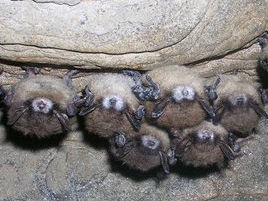The disease that has killed more than 6 million bats in North America hasn’t spared Georgia.
Since white-nose syndrome was first found here in 2013, the number of bats has plummeted by about 90 percent in caves and mines the Georgia Department of Natural Resources surveys each winter.
“They’re just gone,” said Katrina Morris, lead bat researcher for DNR’s Nongame Conservation Section.
The surveys help gauge the impact of white-nose, or WNS, in the state. Nongame Conservation checked 20 hibernacula or refuges this winter, all but two of them in north Georgia. Morris’ report notes that:
- Sixteen either tested positive for the fungus that causes white-nose, Pseudogymnoascus destructans, or showed signs of being infected.
- In 10 caves checked annually since at least 2014, bat counts are down overall by 92 percent.
- Except for gray bats, no other Myotis bats were seen. While counts of bats in this genus are always low in north Georgia caves, this was the first time researchers found none, Morris said.
First documented in North America in New York in 2007, white-nose has spread through the eastern U.S. and into Canada. The disease took a 1,300-mile leap from Minnesota to Washington in March, when a sick bat near Seattle tested positive. In Georgia, white-nose is confirmed or suspected in 11 counties (see list of counties below). White-nose poses no known risk to humans.
The fungus Pd thrives in the cold and humid conditions characteristic in caves and mines used by hibernating bats. The disease Pd causes is named for the white fungus often found growing on the muzzle and skin of affected bats. The fungus results in bats being awakened too often from hibernation or less intense torpor, and using fat reserves needed for hibernation long before winter is over.
Death rates of 90-100 percent have been seen at some hibernacula. Causes of death vary from starvation to stressed immune systems.
One of the first sites in Georgia documented with white-nose is also one of the most telling examples of the fallout. Counts at Sitton’s Cave, a popular grotto at Cloudland Canyon State Park in northwest Georgia, have shrunk from more than 1,700 bats in 2013 to 62 this year, a 96 percent decline.
Morris said that unlike at some affected hibernacula in the North, where dead or dying bats are found in the snow near entrances, in Georgia “we don’t usually see piles of dead bats. We see missing bats.”
While DNR biologists can only survey a small number of caves, those checked likely represent the larger picture of what’s happening to bats in the northern part of the state, according to Morris. Preliminary data from sampling with mist nets in summer also show that fewer bats are being caught, she said.
There is good news. Some bats are surviving for years at affected sites, and some species, including the federally endangered gray bat, don’t appear to be developing white-nose, though they carry the fungus.
Also, scientists are working to combat white-nose, including an effort involving the U.S. Fish and Wildlife Service and Georgia State University researchers testing a bacterium aimed at inhibiting growth of the fungus.
DNR is following a response plan that outlines steps for raising awareness of the disease, combating its spread, reporting and analyzing bats, and managing related natural resources. DNR has increased surveys to better assess bat populations and worked with cavers to spread the word about white-nose, reduce trips in Georgia caves and follow disinfectant protocols for clothes and gear. Only about 15 percent of Georgia’s caves are on state-managed lands. Learn more at www.georgiawildlife.com/WNS.
Dade
Polk
Walker
Rabun
Gilmer
Floyd
Dawson
Chattooga
Paulding
Pickens
Bartow

http://accesswdun.com/article/2016/5/404462/bat-count
